Yesterday, French actress Michèle Morgan (1920-2016) died. The classic blonde beauty has been one of her country's most popular leading ladies for over five decades. The delicate, sophisticated, and detached star was especially noted for her large, expressive eyes. Today, the second part of our in memoriam for Michèle Morgan, who was 96.

French postcard by Editions P.I., Paris, no. 451. Photo: Sam Lévin.

French postcard by Editions P.I., Paris, no. 184. Photo: Sam Lévin.
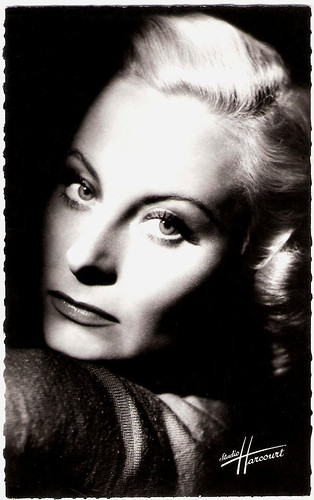
French postcard by Editions du Globe (E.D.U.G.), no. 66. Photo: Studio Harcourt.
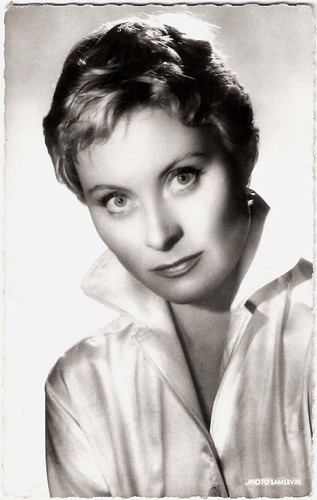
French postcard by Editions du Globe, Paris, no. 616. Photo: Sam Lévin.

East German postcard by VEB Progress Film-Vertrieb, Berlin, no. 810. Retail price: 0,20 DM. Publicity still for Les orgueilleux / The Proud Ones (Yves Allégret, Rafael E. Portas, 1953).

French postcard by Editions P.I., Paris, no. 133, offered by Biscuits Victoria, Bruxelles. Photo: Gibé.
During the 1950s, Michèle Morgan continued to be a major star of European cinema. She regularly co-starred with her husband, Henri Vidal. Their films together include La belle que voilà / Here Is The Beauty (Jean-Paul Le Chanois, 1950), L'étrange Mme X / The Strange Madame X (Jean Grémillon, 1951), the lavish historical epic Napoléon (Sacha Guitry, 1955) in which she played Josephine, and Pourquoi viens-tu si tard? / Why Do You Come So Late? (Henri Decoin, 1959).
She appeared opposite idol Gérard Philipe in Les Orgueilleux / The Proud Ones (Yves Allégret, 1953) and in the bittersweet Les Grandes Manœuvres / Grand Manoeuvre (René Clair, 1955). Hal Erickson at AllMovie about the latter: "Phillipe plays a dashing dragoon officer, vintage 1913, who wagers his friends that he can make the next woman who enters the room fall in love with him. In strides drop-dead gorgeous Michele Morgan, and the rest writes itself. Phillipe plans a slow seduction and a quick goodbye; Morgan, need we say, is no 'goodbye girl'."
She starred in the historical film Marie-Antoinette reine de France / Marie Antoinette Queen of France (Jean Delannoy, 1956). Morgan plays the Austrian princess who becomes the last Queen of France in the waning years of the 18th century. She also appeared in the American production The Vintage (Jeffrey Hayden, 1957) with Pier Angeli and Mel Ferrer.
In the remake, Menschem im Hotel / Grand Hotel (1959), Morgan played the role of Grusinskaya, which was originally portrayed by Greta Garbo in the award-winning 1932 classic Grand Hotel. Based on a book by Vicki Baum, all of the action takes place in the course of one day in a luxury hotel in Berlin. Grusinkaya is a ballerina staying at the hotel. Other guests include a sophisticated thief (O.W. Fischer), a dying man (Heinz Rühmann), a businessman (Gert Fröbe), and a stenographer (Sonja Ziemann). Hal Erickson: "Events intertwine the lives of these strangers, bringing them together for some dramatic moments but not quite as effectively as in the 1932 film."
Henri Vidal suddenly died in 1959. A year later, Morgan married film director and actor/writer Gérard Oury and stayed with him till his death in 2006.

French postcard by Editions du Globe, Paris, no. 579. Photo: Studio Harcourt.
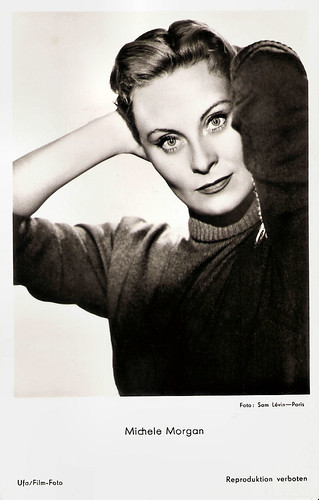
German postcard by Ufa, Berlin-Tempelhof, no. FK 418. Photo: Sam Lévin, Paris.

French postcard by Editions P.I., Paris (License holder in France for Ufa), no. FK 17A. Offered by Les carbones Korès 'Carboplane'. Photo: Arthur Grimm / Ufa.

French postcard by Editions du Globe, Paris, no. 283. Photo: Studio Harcourt.

Dutch postcard, no. 960.
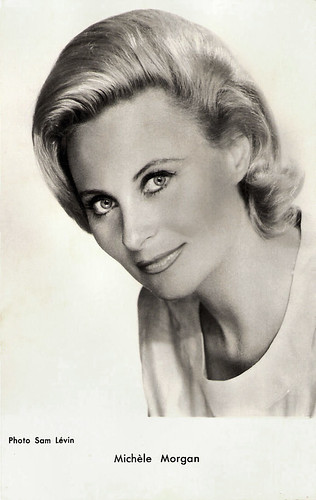
French postcard by Editions P.I., offered by Les Carbones Korès Carboplane, no. 1137. Photo: Sam Lévin.
Michèle Morgan appeared in three films with her third husband, actor and director Gérard Oury: La belle que voilà / Here Is The Beauty (Jean-Paul Le Chanois, 1950), Le miroir à deux faces / The Mirror has Two Faces (André Cayatte, 1958) and Un homme et une femme, 20 ans déjà / A Man and a Woman: 20 Years Later (Claude Lelouch, 1986). She also worked under his direction in a segment of Le crime ne paie pas / Crime Does Not Pay (Gérard Oury, 1962).
Her career took a downturn when the French Nouvelle Vague (New Wave) movement came along in the late 1950s. Its key directors decided to cut ties with the classic French cinema, which many of them had largely despised since the days they had been serving as critics for the Cahiers du cinéma. The only film she did by a Nouvelle Vague auteur was Claude Chabrol's Landru (1963), about French serial killer Henri-Desire Landru (Charles Denner), who wined, dined, scammed, and dismembered over 10 women during WWI. Morgan played a victim, who was eventually burned down by Landru to go up in smoke.
Throughout the 1960s, Morgan continued working in the international cinema. She appeared in films like the Italian historical drama Il fornaretto di Venezia / The Scapegoat (Duccio Tessari, 1963) with Jacques Perrin, the American war drama Lost Command (Mark Robson, 1966) starring Anthony Quinn, and the French comedy Benjamin (Michel Deville, 1968) with Catherine Deneuve and Pierre Clémenti.
In 1968, she largely retired from the screen, but has occasionally returned in films like Le Chat et la souris / Cat and Mouse (Claude Lelouch, 1975) with Serge Reggiani, and Stanno tutti bene / Everbody's Fine (Giuseppe Tornatore, 1990) with Marcello Mastroianni. About the first, D.B. DuMonteil notes at IMDb: "Lelouch really plays cat and mouse with the audience as Detective Lechat (sic)(Regggiani) does with his still attractive suspect (or is it the other way about?). There are plenty of funny scenes and some witty lines. (...) Objections: There are not enough scenes where Reggiani and Morgan are together".
From the 1970s on, she concentrated on painting, designing ties and writing poems. As a painter, she has had several successful exhibitions in Paris. She established her own tie label, 'Cravats Michèle Morgan', in the late 1970s. In 1977, she published her autobiography 'Avec ces yeux-là (With Those Eyes). In the 1980s and 1990s, she also appeared in different TV films and miniseries. Michèle Morgan was named Chevalier of the Légion d'honneur (Legion of Honour) in 1969, and she was made an Officer of the Ordre national du Mérite (French National Order of Merit) in 1975. Morgan also has a star on the Hollywood Walk of Fame. And in 1992, she was given an Honorary César Award for her long service to the French cinema.
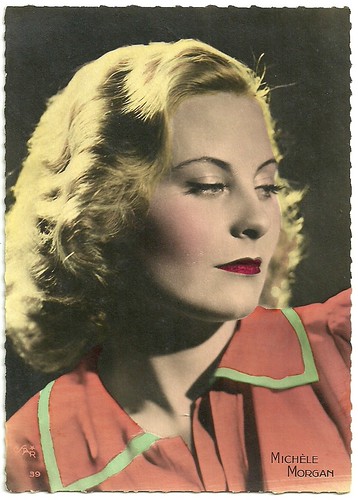
French postcard by Editions P.I., Paris, no. 39. Photo: Star.

French postcard by Editions P.I., Paris, no. 1009. Photo: Sam Lévin.
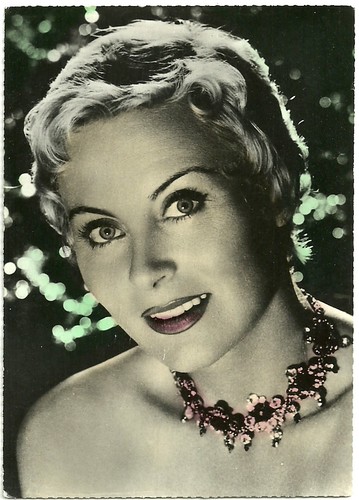
French postcard by Z K, no. 1937.
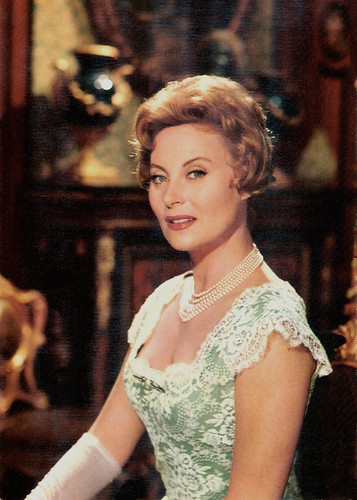
Italian postcard by Rotalcolor, Milano, no. 72.

German postcard by ISV, no. B 15. Photo: MGM.
Trailer for Les Orgueilleux / The Proud Ones (Yves Allégret, 1953). Source: Plamen Plamenov (YouTube).
Trailer for The Vintage (1957). Source: Luis Peix (YouTube).
Sources: Hal Erickson (AllMovie - Page now defunct), Gary Brumburgh (IMDb), DB DuMonteil (IMDb), Wikipedia, AllMovie, and IMDb.
This post was last updated on 31 October 2025.

French postcard by Editions P.I., Paris, no. 451. Photo: Sam Lévin.

French postcard by Editions P.I., Paris, no. 184. Photo: Sam Lévin.

French postcard by Editions du Globe (E.D.U.G.), no. 66. Photo: Studio Harcourt.

French postcard by Editions du Globe, Paris, no. 616. Photo: Sam Lévin.

East German postcard by VEB Progress Film-Vertrieb, Berlin, no. 810. Retail price: 0,20 DM. Publicity still for Les orgueilleux / The Proud Ones (Yves Allégret, Rafael E. Portas, 1953).

French postcard by Editions P.I., Paris, no. 133, offered by Biscuits Victoria, Bruxelles. Photo: Gibé.
No goodbye girl
During the 1950s, Michèle Morgan continued to be a major star of European cinema. She regularly co-starred with her husband, Henri Vidal. Their films together include La belle que voilà / Here Is The Beauty (Jean-Paul Le Chanois, 1950), L'étrange Mme X / The Strange Madame X (Jean Grémillon, 1951), the lavish historical epic Napoléon (Sacha Guitry, 1955) in which she played Josephine, and Pourquoi viens-tu si tard? / Why Do You Come So Late? (Henri Decoin, 1959).
She appeared opposite idol Gérard Philipe in Les Orgueilleux / The Proud Ones (Yves Allégret, 1953) and in the bittersweet Les Grandes Manœuvres / Grand Manoeuvre (René Clair, 1955). Hal Erickson at AllMovie about the latter: "Phillipe plays a dashing dragoon officer, vintage 1913, who wagers his friends that he can make the next woman who enters the room fall in love with him. In strides drop-dead gorgeous Michele Morgan, and the rest writes itself. Phillipe plans a slow seduction and a quick goodbye; Morgan, need we say, is no 'goodbye girl'."
She starred in the historical film Marie-Antoinette reine de France / Marie Antoinette Queen of France (Jean Delannoy, 1956). Morgan plays the Austrian princess who becomes the last Queen of France in the waning years of the 18th century. She also appeared in the American production The Vintage (Jeffrey Hayden, 1957) with Pier Angeli and Mel Ferrer.
In the remake, Menschem im Hotel / Grand Hotel (1959), Morgan played the role of Grusinskaya, which was originally portrayed by Greta Garbo in the award-winning 1932 classic Grand Hotel. Based on a book by Vicki Baum, all of the action takes place in the course of one day in a luxury hotel in Berlin. Grusinkaya is a ballerina staying at the hotel. Other guests include a sophisticated thief (O.W. Fischer), a dying man (Heinz Rühmann), a businessman (Gert Fröbe), and a stenographer (Sonja Ziemann). Hal Erickson: "Events intertwine the lives of these strangers, bringing them together for some dramatic moments but not quite as effectively as in the 1932 film."
Henri Vidal suddenly died in 1959. A year later, Morgan married film director and actor/writer Gérard Oury and stayed with him till his death in 2006.

French postcard by Editions du Globe, Paris, no. 579. Photo: Studio Harcourt.

German postcard by Ufa, Berlin-Tempelhof, no. FK 418. Photo: Sam Lévin, Paris.

French postcard by Editions P.I., Paris (License holder in France for Ufa), no. FK 17A. Offered by Les carbones Korès 'Carboplane'. Photo: Arthur Grimm / Ufa.

French postcard by Editions du Globe, Paris, no. 283. Photo: Studio Harcourt.

Dutch postcard, no. 960.

French postcard by Editions P.I., offered by Les Carbones Korès Carboplane, no. 1137. Photo: Sam Lévin.
Cravates Michèle Morgan
Michèle Morgan appeared in three films with her third husband, actor and director Gérard Oury: La belle que voilà / Here Is The Beauty (Jean-Paul Le Chanois, 1950), Le miroir à deux faces / The Mirror has Two Faces (André Cayatte, 1958) and Un homme et une femme, 20 ans déjà / A Man and a Woman: 20 Years Later (Claude Lelouch, 1986). She also worked under his direction in a segment of Le crime ne paie pas / Crime Does Not Pay (Gérard Oury, 1962).
Her career took a downturn when the French Nouvelle Vague (New Wave) movement came along in the late 1950s. Its key directors decided to cut ties with the classic French cinema, which many of them had largely despised since the days they had been serving as critics for the Cahiers du cinéma. The only film she did by a Nouvelle Vague auteur was Claude Chabrol's Landru (1963), about French serial killer Henri-Desire Landru (Charles Denner), who wined, dined, scammed, and dismembered over 10 women during WWI. Morgan played a victim, who was eventually burned down by Landru to go up in smoke.
Throughout the 1960s, Morgan continued working in the international cinema. She appeared in films like the Italian historical drama Il fornaretto di Venezia / The Scapegoat (Duccio Tessari, 1963) with Jacques Perrin, the American war drama Lost Command (Mark Robson, 1966) starring Anthony Quinn, and the French comedy Benjamin (Michel Deville, 1968) with Catherine Deneuve and Pierre Clémenti.
In 1968, she largely retired from the screen, but has occasionally returned in films like Le Chat et la souris / Cat and Mouse (Claude Lelouch, 1975) with Serge Reggiani, and Stanno tutti bene / Everbody's Fine (Giuseppe Tornatore, 1990) with Marcello Mastroianni. About the first, D.B. DuMonteil notes at IMDb: "Lelouch really plays cat and mouse with the audience as Detective Lechat (sic)(Regggiani) does with his still attractive suspect (or is it the other way about?). There are plenty of funny scenes and some witty lines. (...) Objections: There are not enough scenes where Reggiani and Morgan are together".
From the 1970s on, she concentrated on painting, designing ties and writing poems. As a painter, she has had several successful exhibitions in Paris. She established her own tie label, 'Cravats Michèle Morgan', in the late 1970s. In 1977, she published her autobiography 'Avec ces yeux-là (With Those Eyes). In the 1980s and 1990s, she also appeared in different TV films and miniseries. Michèle Morgan was named Chevalier of the Légion d'honneur (Legion of Honour) in 1969, and she was made an Officer of the Ordre national du Mérite (French National Order of Merit) in 1975. Morgan also has a star on the Hollywood Walk of Fame. And in 1992, she was given an Honorary César Award for her long service to the French cinema.

French postcard by Editions P.I., Paris, no. 39. Photo: Star.

French postcard by Editions P.I., Paris, no. 1009. Photo: Sam Lévin.

French postcard by Z K, no. 1937.

Italian postcard by Rotalcolor, Milano, no. 72.

German postcard by ISV, no. B 15. Photo: MGM.
Trailer for Les Orgueilleux / The Proud Ones (Yves Allégret, 1953). Source: Plamen Plamenov (YouTube).
Trailer for The Vintage (1957). Source: Luis Peix (YouTube).
Sources: Hal Erickson (AllMovie - Page now defunct), Gary Brumburgh (IMDb), DB DuMonteil (IMDb), Wikipedia, AllMovie, and IMDb.
This post was last updated on 31 October 2025.
No comments:
Post a Comment